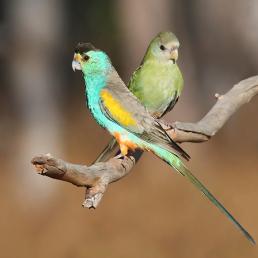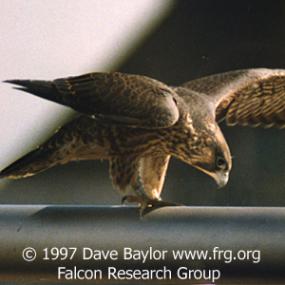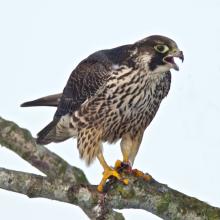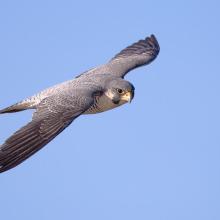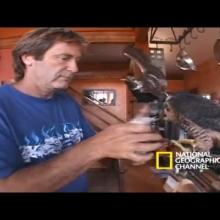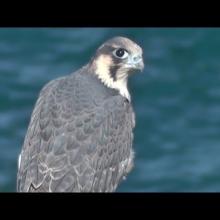

Join BirdNote tomorrow, November 30th!
Illustrator David Sibley and actor H. Jon Benjamin will face off in the bird illustration battle of the century during BirdNote's Year-end Celebration and Auction!
By June, many young Peregrine Falcons are ready to leave the safety of the aerie and go off on their own. A young bird lifts off and heads ... where? With a little luck, the young falcon will make it safely to a nearby ledge, whether cliff or skyscraper. Juveniles stay close to their nesting site for several weeks, dependent on their parents for food. They stoop on each other in flight, learning the skills they'll need to catch prey in mid-air. Learn more about the Peregrine Falcon at Cornell's All About Birds.
BirdNote®
Peregrines Take Wing
Written by Ellen Blackstone
This is BirdNote!
[Cakking of Peregrine]
It’s June, the month that many young Peregrine Falcons fledge, leaving the safety of the aerie. For a week or more, they race the length of the high ledge where they hatched. Sometimes, they flap their wings so vigorously, you’d think they’d propel themselves into the void, long before they are ready. Now, after six weeks of nearly constant attention on the part of their parents, the chicks, or eyasses (pronounced EYE-uhs-uz), are ready to go off on their own. Well, sort of… [Cakking of Peregrine]
Young males go first. They’re about 30% smaller than females and mature faster. The young bird lifts off and heads …. where? With a little luck, the young falcon will make it safely to a nearby ledge—whether cliff or skyscraper. As much as a week later, the young female takes off, too. She and the juvenile male will stay close to their nesting site for several weeks, still dependent on their parents for food. [Juvenile food-begging] Like young children, they play, chasing each other and grappling talons in mock combat. Stooping on each other in flight, they learn the skills they’ll need to catch prey in mid-air. And come autumn, they’ll truly be on their own. [Cakking of Peregrine]
BirdNote writers include Bob Sundstrom, Todd Peterson, Dennis Paulson, and Ellen Blackstone. I’m Frank Corrado.
###
Audio provided by The Macaulay Library at the Cornell Lab of Ornithology, Ithaca, New York. Peregrine Falcon recorded by G. Vyn. Juvenile begging call recorded by A.L. Priori. Ambient recorded by G.A. Keller.
Producer: John Kessler
Executive Producer: Chris Peterson
© 2009 Tune In to Nature.org Revised for June 2009
ID#061907PEFA4KPLU PEFA-04-2009-06-22-
Primary fact reference: Ratcliffe, Derek, The Peregrine Falcon. Buteo Books, 1980
